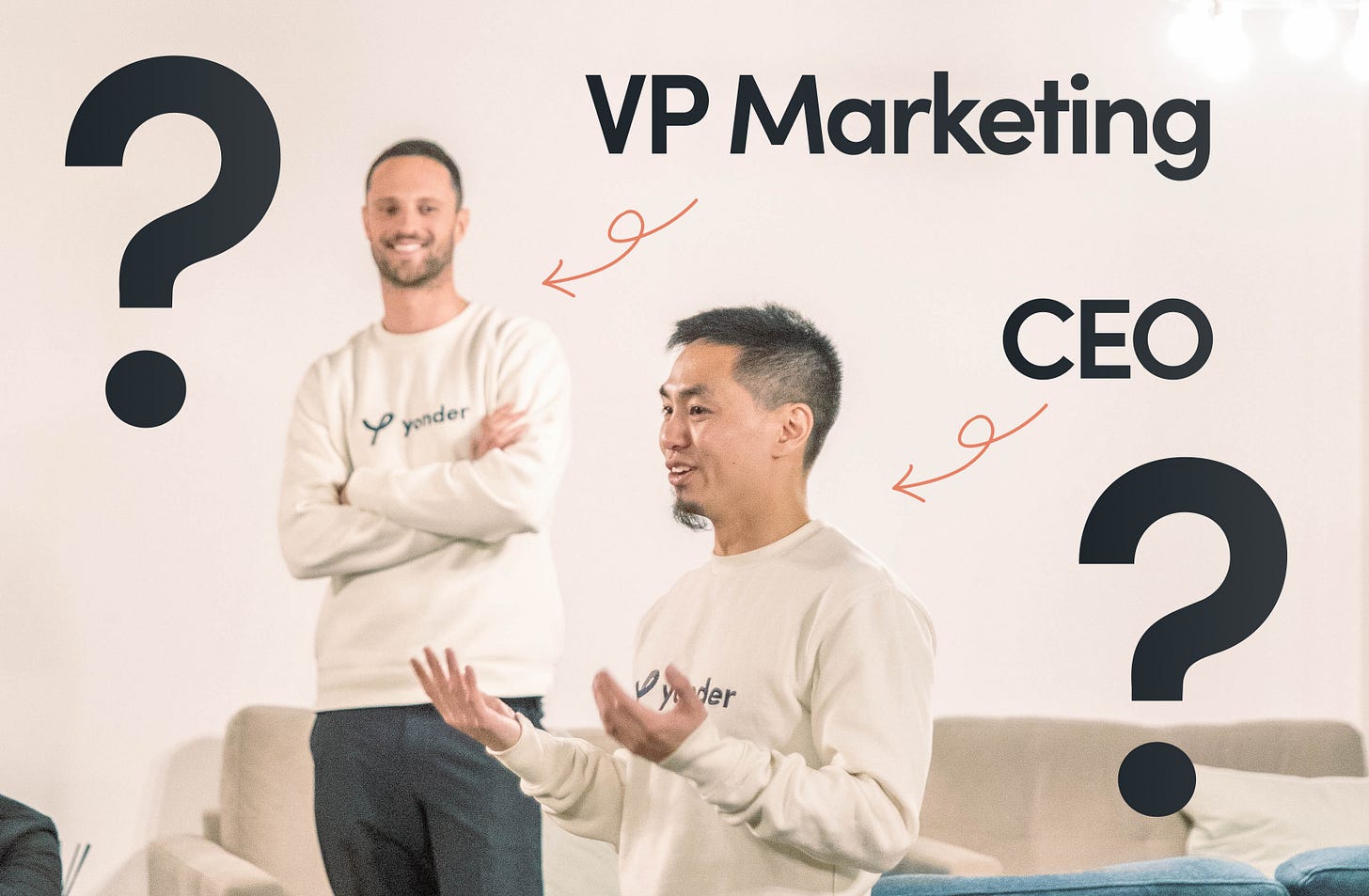The CMO’s Guide To Working With A CEO
What I’ve found to be the essential components of a strong CMO / CEO relationship, which I believe to be one of the most important in any organisation.
Hello friends. I’m coming to you from seat 26D on an EasyJet flight back to the UK. There’s a screaming baby next to me, my knees are pressed against the seat in front of me and I’m both too hot and too cold at the same time.
So I’m in the ideal frame of mind to reflect on my working relationship with my CEO and the experience we’ve had growing together over the last few years.
Before we get into the good stuff, it’s worth highlighting that I think Tim is brilliant (performance review next week…) and so I’m sure he won’t mind me reflecting on our working relationship publicly. No less because Tim is the one who taught me the value of genuine self-reflection so if anything this was his idea and the act of writing this shows how much I’ve learned from him.
After four years working together, Tim and I enjoy a positive and constructive working relationship. We still fall out, disagree and bump heads regularly, but it’s always respectful and with the betterment of Yonder in mind. It’s not perfect, and we’re still working on it, but it’s what I believe all CEOs and effective CMOs should strive for.
It hasn’t always been that way
Four years is a long time working closely with someone and throughout that time our relationship has grown and changed. We’ve had great highs and really difficult lows together.
And let me tell you, the lows have been low. Someday a therapist will help me unravel the masochism underpinning my startup career but for now it’s Substack.
I wanted to reflect here on what I’ve found to be the essential components of a strong CMO / CEO relationship which I believe to be one of the most important in any organisation.
That’s not to downplay the brilliant work of other vital leadership roles like COOs, CTOs, CFOs etc. but given growth is the single most important thing for startups, how a CEO and marketing leader work together can truly make or break a startup’s success.
Let’s go back to the beginning
Tim plucked me from Monzo when Yonder was just a twinkle in his eye. Together with Harry and Theso, they’d defined a problem they wanted to solve but acknowledged their heavy technical experience left them pretty light on design and marketing. So their first two hires were a designer and a marketer.
Our first year together was a fruitful one, together with a small team we blitzed our regulator approval and launched a killer product to market that somehow managed to forge a clear identity and proposition in one of the most competitive consumer finance markets in the world. Things were looking good. I’ve written about this period below.
But despite some great early success, my role as Head of Marketing was so much more than just building a strong brand and product proposition and within a few months I found myself in the most challenging period of my career.
Then came the Trough of Sorrow
After a great launch we found it really hard to build on the early spikes of growth we’d seen from our hugely successful launch campaign.

We didn’t know it at the time, but we’d landed ourselves squarely into a period known as the Trough of Sorrow, something Andrew Chen has written about above that many startups experience after successful launches who haven’t yet learned how to grow consistently.
Reflecting on this now, it made total sense. How would we know how to grow when we’ve only just launched? It was here I first experienced some classic CEO / CMO organisational and relational issues.
Problem #1: Using growth assumptions from other businesses
No two businesses are the same. I wrote about this a while ago around the theme of ‘this growth advice is probably useless’. A lot of growth advice and best practices are also quite misguided.
The narrative that Monzo grew entirely from word-of-mouth is unhelpful, and frankly, untrue. They spent loads on performance marketing to get their flywheel running. It’s important that you leave all of your assumptions at the door and use the information you have to inform your forecasting and planning.
When we started Yonder we were told that a £5 acquisition cost is what we should aim for. “This is what the market expects” investors had told us. But three years on, we’re really happy if we can acquire customers for 10x that. If we’d have stuck with that assumption we’d never have allowed ourselves to learn how to grow our business because there’s no way we’d ever have been able to spend that effectively so early on.
Problem #2: Growth is a marketer’s responsibility
When things slowed down, the entire business looked to me to solve our growth challenges on my own. Literally. In our weekly kickoff they’d look at me and say – “so what’s the plan?”
We know now that this expectation is extremely unreasonable and unhelpful. Growth is a combination of the products you offer, the markets you operate in, and how you reach your target market. Things turned around for us when we started looking at how everyone could contribute to our growth challenges throughout the funnel.
This one is an important lesson for marketers to get ahead of. If you’re a marketing leader working at a pre-product startup, it’s vital you start to socialise the concept that growth is everyone’s responsibility. Don’t make the mistake I made and work this out too late in the game.
Problem #3: Only using top down forecasting
We were relying on our finance manager to set our growth targets by taking our budget and dividing it by a target CPA. But we didn’t know at the time that that wasn’t the right way to think about it.
The mistake I made here was not being involved in this process. But in my defence, I hadn’t ever done a forecast so in the absence of me doing that, we went with the top down ones. The end result was a huge amount of pressure to deliver on unrealistic targets.
Things got a lot easier when I sat down and worked out what growth would look like with all the channels and initiatives we had in flight.
All of these made things extremely hard
A lot of these mistakes were also just symptomatic of many people at Yonder doing their job for the first time. I was a first time Head of Marketing with a background in product marketing. Tim was a first time founder with a background in product development. Everyone at Yonder was learning on the fly so while it’s easy for me to reflect on what we could have done differently now, I think we needed to go through that process of learning and in fact expecting that is probably what I would encourage any founders reading this to get ready for.
At the end of the day, a combination of some unreasonable expectations together with my lack of experience diagnosing and articulating that meant we got into a really tricky position where growth was slowing and I couldn’t work out what to do.
I found it impossible to ask for help. It was a wicked combination that lead to serious burnout. For months we slugged through this, inching forward but never really getting to the root cause of both our organisational and marketing problems.
Here’s how we turned things around
Start with empathy
I used to have this general feeling that Tim was being quite hard on me. Expectations were unreasonable. Market demands were unfair. I had plenty of excuses for why things weren’t going so well and they were all his fault.
A lot of this changed when I put myself in his shoes. A CEO’s job is to keep the company alive. They’re responsible for the livelihoods of dozens of people working for them. They’re accountable to thousands of customers. They’re eating shit from up down and around. It’s an extremely difficult job to balance all the needs of the organisation at once.
My view used to be “you chose this life, mate” which I think on reflection was unfair and unreasonable. There are some great upsides to starting and running a business, but they come with tremendous sacrifices to their personal health and lives. Once I really thought about this, a lot of the high expectations made sense. It really helped me to contextualise my work in the broader context of the business.
At the same time, Tim learned about marketing so he could better understand and support me. He saw how difficult and nuanced effective marketing can be. I could see him empathising with the challenges around balancing our short and long term marketing investment. I felt supported on our big bets when I needed confidence that they were worth taking, even when we weren’t sure. He bought into the idea that we were selling a considered product that required multiple touch points for customers to take a chance on us. This translated into more patience around how we drive growth as a business.
Empathy has to come from both sides. While there are some more concrete examples below on how to improve your working relationship, this one is the most important and without it the rest won’t be as effective.
Constantly educate the business on how marketing works
I see marketers making this mistake all the time. They get annoyed when people don’t understand their work or what they’re doing.
But really, why would they? A CEO who has never worked in marketing wouldn’t understand why investing in social content is important. A finance manager who has never worked in marketing won’t know why brand building is an important part of a holistic marketing strategy. Stop expecting people to understand your job. If they don’t get it, that’s your problem.
I’ve learned that constantly reminding people about how marketing works and why you’re doing things is vital. I like to emphasise the ‘constantly’ because it’s an ongoing process that never ends.
Start somewhere with measurement
While not all activity will drive growth for your business, it should all ladder up to it over time. So working out what are the leading indicators of growth for your work is really important.
For instance, Share of Search, a measure of how often you are showing up in related search traffic, doesn’t necessarily drive growth. But it’s a leading indicator of it, meaning if our Share of Search increases then we can reasonably expect that to improve growth even if we can’t measure it directly. Start tracking these things because you have to start somewhere.
Connect your work back to the broader organisational goals as best you can or they’ll always wonder what’s the point. Here’s an example:
“We’re working on this social content idea because we know that driving views and engagement is a leading indicator for growth and plays an important role in our customer purchase journeys.”
Or
“We’re investing in this out-of-home campaign and we expect to see organic search traffic grow, increased share-of-voice and greater website conversion over the next six months”
If you can frame conversations like this, you’ll never get the “why did your Instagram video drive any growth”.
Marketing measurement isn’t about connecting every single activity to a particular customer’s purchase journey. It’s about being clear on the role each part of your strategy plays and measuring that in a way that is reasonable and easy for others to understand.
Learn how a business works
One of the most important areas of my development over the years has been in learning about how all elements of a business work together.
Understanding how to read and give feedback on a P&L from the finance team, how engineering breaks down complex product problems and solves them, or what keeps your compliance team up at night.
All of these things will make you a more well-rounded marketer. The more you know about how an organisation works, the more you’ll be able to contextualise your work within it.
All of this takes time
All of the above is a pretty swift summary of four years of relationship building, reflection and learning. You can’t rush this process but without starting it you’ll never see the progress you need for this relationship to flourish.
And without putting in the time and effort, your organisation will struggle to grow and you’ll likely not survive the difficult periods that will inevitably pop up.
Good luck!
While I’ve got you…
Do you also think Marketing is Hard!?
I sure do. If you're a senior marketer at a startup, this Substack is for you. I write about what actually works in startup marketing (and when I try it and fail, what definitely doesn't) for marketers on the verge of breakdown.
About me
I’ve launched products at some of the UK’s most loved consumer brands and been the founding marketer and now VP Marketing at Yonder, a modern day rewards card. Since starting Yonder, I’ve written about all my marketing learnings along the way.
Stay in touch
You can also find me on LinkedIn congratulating my mates on their new jobs, trolling Forbes articles about billionaires, and occasionally sharing something useful when absolutely forced to.
Work with me
I do some 1:1 consulting from time to time where my speciality is helping you understand why your brilliant product isn't selling itself. Contact me on LinkedIn if you're into that sort of thing.
Who are you?
I’d love to learn more about who reads this so I can write more useful stuff. I know you ask your customers to take surveys, so one won’t hurt you. Thanks in advance.
Tell your mates
Word of mouth is the best kind of marketing, so send this to your marketer friends who are also pretending they know what they're doing. We’re in it together.





The discussion about measurement and leading indicators is particularly relevant. We're currently struggling with connecting our marketing activities to business outcomes.
Could you share more about how you developed your Share of Search metric? Also, how do you handle the challenge of measuring brand-building activities that don't have direct attribution to growth?
The section about growth being everyone's responsibility is crucial. In my experience, this mindset shift is often the hardest to implement, especially in early-stage startups.
I'm curious about your approach to getting other departments involved in growth initiatives. Have you developed any specific frameworks or processes to help non-marketing teams contribute to growth goals? Also, how do you handle the tension between short-term growth metrics and long-term brand building?